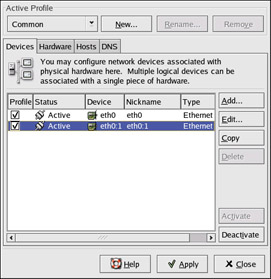Device Aliases
|
Device aliases are virtual devices associated with the same physical hardware, but they can be activated at the same time to have different IP addresses. They are commonly represented as the device name followed by a colon and a number (for example, eth0:1). They are useful if you want to have more than one IP address for a system but the system has only one network card.
If you have configured a device such as eth0, click the Add button in the Network Administration Tool to create an alias for the device. Select the network device and configure the network settings. The alias will appear in the device list with a device name followed by a colon and the alias number.
| Warning | If you are configuring an Ethernet device to have an alias, neither the device nor the alias can be configured to use DHCP. You must configure the IP addresses manually. |
Figure 13-19 shows an example of one alias for the eth0 device. Notice the eth0:1 device — the first alias for eth0. The second alias for eth0 would have the device name eth0:2, and so on. To modify the settings for the device alias, such as whether to activate it at boot time and the alias number, select it from the list and click the Edit button.

Figure 13-19: Network device alias example
Select the alias and click the Activate button to activate the alias. If you have configured multiple profiles, select which profiles in which to include it. To verify that the alias has been activated, use the command /sbin/ifconfig. The output should show the device and the device alias with different IP address:
eth0 Link encap:Ethernet HWaddr 00:A0:CC:60:B7:G4 inet addr:192.168.100.5 Bcast:192.168.100.255 Mask:255.255.255.0 UP BROADCAST RUNNING MULTICAST MTU:1500 Metric:1 RX packets:161930 errors:1 dropped:0 overruns:0 frame:0 TX packets:244570 errors:0 dropped:0 overruns:0 carrier:0
collisions:475 txqueuelen:100 RX bytes:55075551 (52.5 Mb) TX bytes:178108895 (169.8 Mb) Interrupt:10 Base address:0x9000 eth0:1 Link encap:Ethernet HWaddr 00:A0:CC:60:B7:G4 inet addr:192.168.100.42 Bcast:192.168.100.255 Mask:255.255.255.0 UP BROADCAST RUNNING MULTICAST MTU:1500 Metric:1 Interrupt:10 Base address:0x9000 lo Link encap:Local Loopback inet addr:127.0.0.1 Mask:255.0.0.0 UP LOOPBACK RUNNING MTU:16436 Metric:1 RX packets:5998 errors:0 dropped:0 overruns:0 frame:0 TX packets:5998 errors:0 dropped:0 overruns:0 carrier:0 collisions:0 txqueuelen:0 RX bytes:1627579 (1.5 Mb) TX bytes:1627579 (1.5 Mb)
|
EAN: 2147483647
Pages: 278